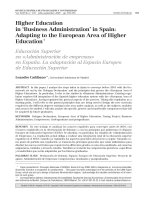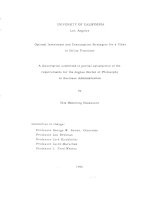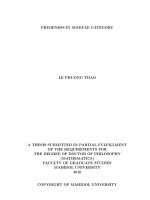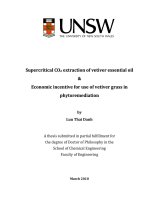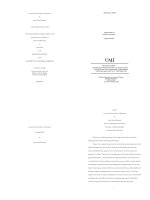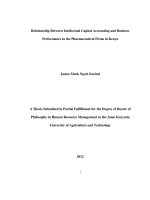A dissertation submitted in partial satisfaction of the requirements for the degree Doctor of Philosophy in Business Administration potx
Bạn đang xem bản rút gọn của tài liệu. Xem và tải ngay bản đầy đủ của tài liệu tại đây (7.69 MB, 143 trang )
UNIVERSITY
OF
CALIFORNIA
Los Angeles
Optimal Investment and Consumption Strategies for a Class
of Utility Functions
A
dissertation submitted in partial satisfaction of the
requirements for the degree Doctor of Philosophy
in Business
Administration
Nils Hemming Hakansson
Committee in charge:
Professor George
W.
Brown, Chairman
Professor Leo Breiman
Professor Jack Hirshleifer
Professor Jacob Marschak
Professor J, Fred Weston
Copyright
by
NILS
HEMMING
HAKANSSON
The
diaclerta;tion
of
Nib
Hemming
Hakaneson
is
appsoved,
and
it
is
acceptable
In
quality
and
form
for
publication
on
mlcrof'ilm:
*
r
Committee
Chairman
Unlveraity
of
California,
Ins
Augeles
TABLE OF CONTENTS
LIST OF TABLES
LIST
OF
FIGURES
ACKNOWLEDGMENTS
VITA
ABSTRACT
v
vi
vii
viii
ix
Page
Chapter
THE
BUILDING BLOCKS
1.
1
Investment vs. Consumption
1.
2
The Utility Function.
1.
2.
1
Koopmans' Impatience Study
,
.
.
1.
2. 2
Properties and Limitations of the
Utility Function
1.
2.
3
Note on the Boundedness of the
Utility Function
1.
3
The Opportunity Set
1.
3.
1
Opportunities for Decision
1.
3.
2
Opportunities for Non-Capital
Income
1.
3.
3
Productive Investment Opportunities
.
1.
3.
4
Financial Opportunities
THE MODEL AND ITS IMPLICATIONS.
.
2. 1 Summary
of
Notation
2. 2
Derivation of the ~asic Model
2,
3
The Solution When u(xy)
=
u(x)
/u(~)
1
2.3.1 Model
I
2.3.2 ModelII.
2.
4
The Solution When. u(xy)
=
u(x)
+
u(y)
2.
5
The Solution Wher, u(x
t
y)
=
u(x)
(u(~)
1
,
,
.
.
2.
6
Properties
of
the Optimal Consumption
Strategies
2.
6.
1
Effect of Impatience Rate.
2.
6.
2 Effect of Risk Aversion
Index
2.
6.
3
Effect of the "Favorableness" of the
Investment Opportunities
2.
7
The Behaviour of Capital.
iii
TABLE OF CONTENTS (Cont)
2
.
8
Properties of the Optimal Borrowing and
Lending Strategies
2
.
8
.
1
The Existence of a Market Interest
Rate
2
.
8
.
2 Different Rates for Borrowing and
Lending
2
.
9
Properties of the Optimal Investment
Strategies
2.10 Generalizations
2
.
10
.
1 Finite Horizon
2
.
10
.
2
Non-Constant Non- Capital Income
Stream
2
.
10.
3
Time -Dependent Probability
Distributions
2
.
11 Implications with Respect to the Theory of
The Firm
.
.
2
11
1
Bases fcr the Formation of Firms
2. 11
.
2
The
Firm's
Objective and Its Optimal
Capital Structure
2 .
11
.
3
The Debt of the Firm: Limited Liability
.
.
111
APPLICATIONS AND EXAMPLES.
3
.
1
Individual De cis ion-Making
3
.
2 The Bal.aaced Mutual Fund
3
.
3
Endowed Educational and Charitable Organizations
.
.
IV RELATION TO OTHER MODELS
4
.
1 Fisher's Model of the Individual
.
4
2
Consumptio:? Models
4
.
2
.
1
Classical Models
4
.
2
.
2 Phelps!
.M
ode1
4
.
3
Investment Models
4
.
3
.
1
The
.M
ear -Variance Approach
4
.
3.
2
Chance- Cosstrained Models
4
.
3
.
3
Long-Ru-2 ~nvestment Models
4
.
3.
4
Other Investment Models
4
.
4
The State-Preferezce Approach: A Brief
Comment
4
.
5
Summary
BIBLIOGRAPHY
LIST
OF
TABLES
TABLE
PAGE
I.
Zquivalent Consumption Programs When
u(c)
=
log c
*
11.
Optimal Allocation of Capital (A; Each Decision
Point) for Selected Capital Pocilions When u(c)
=
fi
a
=
.
88,
y
=
$10, 000
in
Each Period, and
r,
P2, P3'
P4
are as in (3-1)
111.
Optimal Allocation of; Capital (At Each Decision
Point) for Selected Capital Positions When
2
~J.(C)
=
-c-
,
cu
=
.
88,
y
=
$10, 000 in Each Period,
and
r,
P2, P3, P4, are
as
in (3-1)
IV.
Optimal Allocation of Capital (At Each Decision
Point) for Selected Capital Positions When
u(c)
=
log c,
a,
=
.
88,
y
=
$10, 000 in Each Period,
and r, P2,
P3,
P4, are as in (3-1).
'
V.
Optimal Allocation
of
Capital (At Each Decision
Point) for Selected Capital Positions When
u(c)
=
-e-,0001c,
Q
=
a
99$
y
=
$lo9 000 in
Ea.ch
Period, r
=
1.06, and
P2
may Assume Each
of
.
.
the Values 96 and 1.
17
w~tl? Probability
5
VI.
Effect of Impatience Rate on Optimal Allocation af
-2
Capital (At Each Decision Point) When u(c)
=
-c
,
y
=
$10, 000 in Each Period, and
r,
P2, P3,
P4,
are as in (3-1)
VII.
Effect of Size of (Con.stant) Non-capital Income
Stream on Optimal A?locatio~ of Capital (At Each
Decision Poist) When
U(C)
=
log c,
a
=
.
90,
and
r,
P2,
B3,
P4, areasin(3-1).
VIII.
Normative Investment and Consumption Models:
A Comparative Summary
FIGURE
1.
2.
LIST
OF
FIGURES
Zones
of Impatience
Fisher's Solution
PAGE
15
104
ACKNOWLEDGMENTS
While the research reported in this study was pri.ncipally conducted
during the academic year 1965-66, many of the underlying ideas are
of an earlier vintage.
These earlier ideas in particular reflect the
influence of several individuals.
My greatest debt is to Professor George
W.
Brown.
The high
standards which he has set have not only benefitted this study but
have profoundly influenced my own development.
Highly generous
in
the giving of his time, Professor Brown has also been
a
continual.
source of inspiration.
I
am also indebted to Professor Jacob Marschak for many early
suggestions and valuable comments, and to Professors Leo Breiman,
Jack Hirshleifer, James Jackson, and J. Fred Weston for construc-
tive criticisms.
I
am grateful to the Ford Foundation for ca.rrying the fi.nancia1
burden of the last three years in the form of two Predoctoral Fellow-
ships and one Dissertation Fellowship, and to the Western Data Pro-
cessing Center of the University of California at Los Angeles for
providing the necessary computational facj-lities. Finally,
I
wish to
express my sincere appreciation to the Western Management
S,'
pieme
Institute of
UCLA
and the RAND Corporation for typing portions of
the early drafts, and to Mrs. Libby
H.
Connor and Mrs. Laurie
Harrington for their excellent typi.ng of the final. manuscript.
June
2,
1937
-
Born
-
Marby, Sweden
1956
-
Studentexamen, 0sterSunds ~groverk, ~stersund, Sweden
1956
-
Royal Swedish Corps of Engineers
1958
-
B.
S.
,
University of Oregon
1958-1960
-
IBM Research Assistant, Western Data Processing
Center, University of California, Los Angeles
1960
-
M,
B. A.
,
University of California, Los Angeles
1960-1963
-
Staff accountant (1960-1962), Consultant (1962-1963),
Arthur Young and Company, Certified Public Account-
ants, Los Angeles, California
1962
-
Certified Public Accountant
(
California)
1963-1966
-
Ford Fellow, Graduate School of Business Admini-
stration, University of California,
Los
Angeles
1964
-
Postgraduate Research Assistant
XI.,
Western Management
Science Institute, University of California, Los Angeles
1965
-
Consultant, the RAND Corporation, Santa Monica.
California
FIELDS OF STUDY
Major Field: Business Administration
Studies in Mathematical Methods
Professors George
W*
Brown, Richard
V.
Evans,
and James
R.
Jackson
Studies in Economics
Professors Jacob Marschak and Frank
E.
Norton, Profes-
sor Karl Borch, Norwegian School of Economi.cs! Bergen
Studies in Accounting
Professors A. B. Carson, Paul Kircher, and Harry
Simdns
Studies in Management Theory
Professdr Harold Koontz
vi'ii
ABSTRACT
OF
THE DISSERTATION
Optimal Investment and Consumption Strategies
For a Class of Utility Functions
Nils Hemming Hakans son
Doctor of Philosophy in Business Administration
University of California, Los Angeles, 1966
Professor George
W.
Brown, Chairman
This res earch formalizes Irving Fisher's model of the individuai
under risk, and represents at the same time
a
generalization of
Pheips' model of personal saving (Econometrica, October 1962). The
objective of the individual is postulated to
be
the maximization of ex-
pected utility from consumptior, over time where the horizon is arbi-
trarily distant. The individual's resources consist
of
an initial capi-
tal positio~ (which may be ~egative) and
a
noc-capital income stream
which is known with certainty but which may possess any time-shape.
The individual faces both financial opportunities (borrowing
and
lend-
ing) and an arbitrary number of productive inve stmeat opportu.nlties.
The interest rate is presumed to be known and invariant over time;
the case when the borrowing rate exceeds the lending rate is examined
for a specialized model.
The returns fromithe productive opportuni-
ties are assumed to be random variables, whose probability distri-
butions may differ from period to peri.od.
The basic (Fisherian)
characteristic of the approach taken is that the portfolio composition
decision, the financing decision, and the consumption decision are
all analyzed simultaneously in
-
one model.
The vehicle of analysis is
discrete-time dynamic programming.
Optimal consumption and investment strategies are derived for the
"3
j-1
class of utility functions
a
u(ci),
0
<
a
<
1,
where ci is the
Y
amount of consumption in period
j,
such that u(c)
=
c
,
0
<
y
<
1,
u(c)
=
-cVY,
y
>
0, u(c)
=
log c, or
u(c)
=
-emYC, y
>
0.
The optimal consumption strategies turn out to be linear and in-
creasing in wealth and in the present value of the non-capital income
stream.
In
three of the four models
studied, the optimal consump-,
tion strategies satisfy the properties specified by the consumption
hypqtheses of Modigliani and Brumberg and of Friedman precise1.y.
The optimal lending and. borrowing strategi.es are
faun-d
to be lin-
ear in wealth.
Three of the models always call for borrowing when
the individual is poor while the fourth model always calls for ler-iding
when he is sufficiently rich.
The optimal investment strategies have the surprising property
that the optimal mix of risky (productive) investments in each model
-"
is independent of the individual's wealth, non- capital income str earn,
and impatience to consume. It is conjectured that the class of utility
functions examined is the only one for which this property of the op-
timal investment strategies holds.
The precedipg result appears to have significant implications with
respect to the theory of the firm. Starting with
a
collection of hetero-
geneous individuals, each of whom is bent on maximizing (his own)
utility from consumption over time, it is shown that there exists a
basis for the formation of firms by sub-collections of individuals,
where each sub-collection in turn possesses significant heterogeneity.
Each firm so formed is found to have a well-defined (unique) objective
function, which may be interpreted as imputing a precise meaning to
the term "profit maximization" under risk and with respect to time.
Since the capital structure of the firm is found to be unimportant, an
unexpected tie-in with Proposition
I
of Modigliani and Miller is
obtained.
CHAPTER
I
THE
BUILDING
BLOCKS
The objective of this research is to derive optimal investment and
consumption strategies for individuals from alternative but fundamen-
tal starting-points, to examine and classify their properties, and to
analyze their economic implications, particularly in respect to the
theory of the firm. The point of view, therefore, is essentially pre-
scriptive, placing the study in the domain of normative decision theor)
In this chapter, the various components of the economic decision
problem to be studied are constructed. The objective of the individual
is postulated to be the maximization of expected utility from consump-
tion over time where the horizon is infinitely distant. The individual's
resources are assumed
to
consist of an initial capital position (which
may be negative) and
a
non-capital income stream which is known with
certainty but which may pos ses s any time- shape. The indi.vidua1 faces
both financial opportunities (borrowing and lending) and an arbitrary
number of productive investment opportunities. The borrowing rate
may exceed the lending rate, but each interest rate is presumed to be
known and invariant over time. The returns from the productive op-
portunities are assumed to be random variables, whose probability
distributions may differ from period to period.
The components developed in Chapter
I
are assembled into a formal
model in Chapter
11,
where the main results are derived.
The funda-
mental characteristic of the approach taken is that the portfo1i.o com-
position decision, the financing decision, and the consumption
-'
decision are
all
analyzed
simultaneously,
The basic model developed
in this study may therefore be viewed as a formalization of Irving
Fisher's model of the individual, as given in The Theory of Interest,
under risk. At the same time, it represents a generalization of
1
Phelps' model of personal saving. The vehicle of analysis is
discrete-time dynamic programming.
Optimal consumption and investment strategies are derived for the
amount of consumption in period
j,
such that either the risk aversion
index -u"(x)/u'(x) or the risk aversion index -xu"(x)/u'(x) is a posi-
tive constant for all finite x
>
0. It is shown that u(x) belongs to this
-
class
if
and only
if
u(x) is strictly concave and satisfies one of the
three "Cauchy" equatio~s u(x
-t
y)
=
u(x)
IU(~)
I,
u(xy)
=
u(x).
-t
u(y),
Y
-7
or ~(xy)
=
U(X)IU(~)I,
i.
e., u(c)
=
c
,
0
<
y
<
1, u(c)
=
-c
,
y
>
0, u(c)
=
log c, or u(c)
=
-elYc,
y
>
0.
Section
2.
6
is devoted to a discussion of the properties of the opti-
mal consumption strategies,which turn out to be linear and increasing
in wealth and in the present value of the non-capital income stream.
Edmund Phelps, "The Accumulation of Risky Capital:
A
Sequential
Utility Analysis,
I'
Econometrica, October 1962.
In three of the four models studied,
the optimal consumption
strategies satisfy the properties specified by the consumption hypo-
theses of Modigliani and Brumberg and of Friedman precisely. The
effects of changes in impatience and in risk aversion on the optimal
amount to consume are found to coincide with one's expectations.
However, in response to changes in the "favorableness" of the invest-
ment opportunities, the four models exhibit an exceptionally diverse
pattern with respect to consumption behaviour.
Necessary and sufficient conditions for capital growth are derived
in
2.
7.
It is found that when the one-period utility function of con-
sumption is logarithmic, the individual will always invest the capital
available after the allotment to current consumption
so
as
to maxi-
mize the expected growth rate of capital plus the present value of the
non- capital income s tr eam.
Section
2.
8
discusses the properties of the optimal lending and
borrowing strategies, which are linear in wealth Three of the
models always call for borrowing when the individual is poor while
the fourth model always calls for lending when he is sufficiently rich.
It appears that a positive rate of interest will always exist in
arc
eco-
nomy composed of individuals obeying one of the four models
as
long
as
the combined wealth
is
(substantially) positive.
The optimal investment strategies have the surprising property
that the optimal mix of risky (productive) investments in each model
is
independent of the individual's wealth, non- capital income stream,
and impatience to consume.
It
is
shown in
2.
9
that the. optimal mix
depends in each case only on the probability distributions of the
,.
L>
returns, the interest rate, and the individual's one-period utility
function of consumption. It is then conjectured in
2.
11 that the class
of
utility functions examined is the only one for which this property of
the optimal investment strategies holds.
The preceding resu1.t appears to have significant implications with
respect to the theory of the firm. Starting with
a
collection of hetero-
geneous individuals, each of whom is bent on maximizing this own)
utility from consumption over time, it is shown in
2.
11 that there
exists a basis for the formation of firms by sub-collections of Indi-
viduals, where each sub-coll.ection in turn possesses significant
heterogeneity.
Each firm so formed is found to have a well-defined
(unique) objective function, which may be interpreted as imputing a
precise meaning
to
the term "profit maximization" under risk an.d
with respect to time,
Since the capital structure of the firm is found
to be unimportant, an unexpected tie-in with Proposition I of
Modigliani and Miller is obtained.
In Chapter
111;
the results obtained in Chapter
IX
are il.lustrated by
means of examples, and some of the appl.ications to which
the
model
lends itself are discussed. It is noted that the model Is app1.icabl.e to
the balanced mutual fund a.s well as to endowed educational and char-
itable organizations,
In
the
last
chapter, the relationship between ths
model developed in this study
a.nd
other investment and consumption
models is examined.
1.1 INVESTMENT
VS,
CONSUMPTION
Fisher defined cdnsumptiori as spending for "more or less imme-
diate enjoyment" and investicg as spending of money for "more or
.
-'
less deferred enjoyment.
"
Turning to the more popular authors,
Loeb,
for example, writes that "the purpose of investment is to have
funds available at a later date for spending.
112
In
a different passage
he states
:
"Any earner who earns more than he can spend is automati-
cally an investor.
It doesn't matter in the slightest whether he rea-
lizes that he is investing.
l~~
While no hard and fast line can be drawn
between what constitutes consumption and what constitutes investment,
consumption is perhaps best viewed as the exchange of present dollars
for immediate or near-immediate pleasures. Investment, by the
same token, may be looked upon as the expenditure of present dollars
in the hope of receiving (future) dollars at some future time.
4
We shall now show, by intuitive reasoning with respect to the in-
vestment decision, that no reasonable a priori basis exists for treat-
ing the investment and the consumption decisions of individuals
non-jointly.
1
Irving Fisher, The Theory of Interest, New York, MacMillan, 1930,
reprinted, Augustus Kelley, 1965, p. 1
14.
Gerald Loeb, The Battle for Investment Survival, New York, Simon
and Schuster, revised ed., 1965, p. 129.
3
Ibid., p.
9.
-
4
By this distinction, the ownership and occupancy of a family home
is clearly both investment and consumption.
The down payment,
including the difference between mortgage payments plus expenses
minus the rental value,
if
positive, constitutes an investment. The
foregone rental income constitutes consumption. The return on the
investment is composed
of
the rental value less mortgage payments
and expenses,
if
positive,
plus the final proceeds from the sale of
the house.
The consumption of food, for example, might also be called an
investment in that it preserves the health necessary for survival.
However, we shall not take this view here.
The investment decision
-
characterization.
The investment
decision, like most problems of decision posed in a realistic way, has
two fundamental characteristics: it is sequential and
it
is taken under
risk or uncertainty.
A
sequential decision problem is a problem ex-
tended in time, in which the consequences thus far of decisions taken
in past periods become initial conditions for present decisions.
A
decision problem under risk or uncertainty is one in which the model
employed does not assume perfect foresight.
The investment objective. Any normative model presumes the ex-
istence and availability of an objective function. Thus, the derivation
of "optimal" investment strategies, for example, is contingent upon
the proper and precise specification of the maximand.
In
the case
01
the firm, there is wide disagreement as to what its objective should be,
a
disagreement which shows no sign of narrowing.
Even if one were
\
to adopt the classi.ca1 postulate of protit maximi.zation, one immedi-
ately runs into conceptual difficulties: what does it mean to maximize
profits under risk or uncertainty? &d even in the case of certainty
one faces the intertemporal question: when do .we maximize profits
?
-
Since
all
claims to the capital of the firm reside
in
Individuals, it
seems reasonable that the objective of the firm should be at least
grounded in the.objectives of the individual investors of equity capital
1
The various objectives suggested in the literature are too numerous
to be discussed here. J7or-a taste of the different proposals, the
reader is referred to Richard Ells,
The Meaning
&f
Modern Busi
-
ness, New York, Columbia university press, 1960, pp. 117-21;
Charles Grainger, "The Hierarchy of Objectives,
"
Harvard Busi-
ness Review, May-June 1964; and Peter Drucker, "The Objectives
of
a
Business,"
The
Practice of Management, New York, Harper
&
Row, 1954,
ppm,
126-129.
If, therefore, one views the objective of the firm as derived, in some
fashion, from the investment objectives of individuals, the latter be-
come a logical starting-point
ill
an examination of investment objec-
tives in general.
While the object of investment activity is capital, capital per se
offers nothing to the individual u.ntil it is spent. Thus, the value, or
utility, of capital. is determined by the enjoyment derived from the
consumption it buys.
In. the words of Fisher
Money is of no use to us until it is spent. The ultimate
wages are not paid in terms of money but in the enjoy-
ment it buys. The dividend check becomes income in
the ultimate sense only when we eat the food, wear the
clothes, or ride i.n the automobile which are bought with
the check.
Since consumption, therefore, is the ultimate source of all pecu-
niary utility, we are ult-mately led,
in our search for optimal ir~vest-
ment strategies, to consider individuals' utility functions for alterna-
tive consumption programs. But this is exactly what we would do if
we were interested in determini~g his optimal coosumpti.on strategies.
It is clear at this juncture that the individual's economic choice prob-
lem is two-fold: how much to invest (or alternatively,
how much of
one's capital to consume prese~tlyl, and
how to invest that capital
which is not presently consl~med
(i.
e., how to allocate it among
available opportunities).
While these two aspects of the problem
have been examined at length separately,
a
joint investigation of th.e
problem as a whole, with the exception of Fisher's classic work,
~p.
cit., p.
5
The Theory of Interest,
and the writings of Hirshleifer,
still seems
to be lacking.
This is the more surprising since, when the problem
is
viewed in this light, one is hard put to find an a priori reason for
-
assuming the two decisions to be independent of one another.
1.
2
THE UTILITY FUNCTION
The preferences of the individual, then, which must be translated
into an objective function are his preferences for alternative con-
sumption programs. This is so, as we have seen, because only these
preferences are ultimately relevant for his decisions with respect to
both consumption
&
investment.
The most significant work to date on the properties of preference
systems concerning alternative consumption programs is that of
~oo~mans,,~ later extended by Koopmans, Diamond, and Williamson.
3
On the basis of their general significance as well as their important
bearing on this study, Koopmans' findings will be briefly reviewed
here.
-
1.
2. 1 Koopmans' Impatience Study
Proceeding from certain basic behavior postulates concerning the
preference ordering of consumption programs which extend over an
infinite future, Koopmans shows in his two papers the existence of
1
See in particular Jack Hirshleifer, "On the Theory of 0ptima.l 3n-
vestment Decision", The Jour.r\_al of Political Economy, August
1958,
and Jack Hir shleifer, "Investment Decision under Uncertainty:
Choice- Theoretic Approaches", Quarterly Journal of ~conomics,
November 1965.
Tjalling Koopmans, "Stationary Ordinal Utility and Impatience?',
Econometrica, April 1960.
3
Tjalling Koopmans, Peter Diamond, and Richard Williamson,
stationary Utility and Time Perspective", Econornetrica, January-
,
.
April, 1964.
impatience and time perspective in a broad class of such programs.
The notion of impatience goes back to Bohm-Bawerk, who in
-
The
Positive Theory of Capital advanced the idea of preference for early
timing of satisfaction. In Koopmans' work, impatience is essentially
taken to mean that
if
in any given period the consumption of the com-
modity bundle
x
is preferred to that of bundle
x',
then the consump-
tion in consecutive periods of
x,
x' is preferred to that of x', x,
all
other consumption being the same.
The notion of time perspective
will be briefly discussed later.
While formally defined in terms of a utility function, impatience
is viewed as a property of the underlying preference ordering.
This
implies that every utility fun.ction representing the preference order
-
ing must have the impatience property. Consequently, impatience
must be expressed in terms of an ordinal utility function.
An
ordinal
utility function is a utility function which retains its meaning under
a
monotonic increasing transformation, that is,
if
V
is
a
utility func-
tion, so is
U
=
T(V), where T is any monotonic transformation and
Tf(V)
>
0.
The postulates assert continuity, sensitivity, and stationarity of
the utility function, absence of intertemporal complementarity, and
the existence of a worst ar,d a best program. Thus, the papers es-
sentially constitute
a
study of the implications of a continuous and
stationary ordering of infinite consumption programs.
Notation.
The bundle of n commodities consumed in period
j,
j
=
1,
2,
3.
. .
is givenby
where c.
>
0.
An infinite program will be written
J
-
while a constant program will be denoted
Statement of the pos tu.lates. P1 (Existence and continuity). There
exists a utility function U(lc), which is defined for
all
lc such that,
for all
j,
c. is a point of a bounded, convex subset
C
of the n-
J
dimensional commodity space. The function
U(l
c
)
has the continuity
property that,
if
U
is any of the values assumed by that function, and
if
U'
and
U'
'
are numbers such that
U'
<
U
<
U'
'
,
then there exists
a
positive number
6
such that the utility
U(
c') of every program lc'
1
having
a
distance d(lc', c)
'
sup jc;
-
c.
1
<
6,
where lc'
-
cj
1
1
J
J
j
max
1
cik
-
c
from some program c with utility
U(l
c)
=
U
k
j
k 1
satisfies
U'
<
U(lc')
<
U".
Calling the set
{l~~I~j~(
C)
=
u),
where
C
I
CxCx.
.
.
(the
-
1
1
infinite Cartesian product of sets C), the equivalence class defined by
U,
the continuity property given
in
P1 may be termed
uniform
conti-
nuity on each equivalence class. In the first paper,
PI
stipulated
both uniform continuity on each equivalence class
and
unbol~.ndednes s
of C which severely limits the choice of functions
Uo
Evidently
Koopmans chose to sacrifice unboundedness and with it, perhaps,
some realism. The distance function, or metric, also treats all
periods alike, the propriety of which may be questioned. However,
remembering that the presence of impatience is the phenomenon to be
established, this approach certa-lnly provides a neutral. starting
point.
P2 (Sensitivity). There exist first-period consumption vectors c
1'
I
c1 and
a
program c from the second period on, such that
2
This postulate is clea,rly stronger than one which simply requires
that the utility function not be
a
constant. The object is to keep the
utility function from being insensitive to all program changes which
affect a given period. The choice of the first period for this purpose
is arbitrary.
P3
(Limited non-complementarity).
For all el, c;, Zc,
zc
'
U(clr
2~)
-
>
~(c;,
2~)
implies U(c 1'2
c')
-
>
~(c;,
Lc')
I
U(cl,
2~)
-
>
U(cl,
Z~i)
implies U(cl, 2c)
-
>
~(c;, 2c')
This postulate says that the consumption of a particular bundle of
commodities in one period does not affect preferences with respect to
future alternatives. This, of course, is a highly qi~estlonable propo-
sition.
It would perhaps be more palatable
if
total expenditures on
consumption were used instead as
a
measure of satisfaction, but this
idea is rejected
by
Koopmans.
However, here one runs into the rat-
chet principle.
1
The ratchet principle essentially states that the utility of consump-
tion in
a
given period is strong1.y conditioned on the highest level of
consumption previously experienced, particuJ.arly if this level is of
recent origin. This point was first made by James Duesenberry
ic
Income, Saving and the
the or^
of Consumer Behavior, Cambridge,
Massachusetts, Harvard University Press, 1949, pp. 84-85,114116.
As a consequence of
P3,
it can readily be shown that U(lc) may
be written
where u and
T
are uniformly continuous on each equivalence cl3ss
and
Y
is continuous and increasing in
u
and T.
P4
(Stationarity). For some c and all c,
1
2
2CI
U(clr
2~)
-
>
U(cl J.2c')
if
and only if
U(
c)
>
U(2c')
2
-
This postulate asserts that there exists a subset of programs that
differ only from the second period on, the ordering of which is not
changed by advancing the timing of each consumption vector by one
period.
It should be poi~ted out that the orderi~g in question applies
only to the presert.
The passage of time is completely outside the
scope of the postulate set
-
thus, the question of changes in prefer-
ences as a function of time is not considered.
It can be shown that
P3b
and
P4
together imply
U(cl,
2~)
-
>
U(c
c')
if
and only
if
U(
c)
>
U(2c') for all
1' 2
2
-
-
I
cl,
C2'
2c
Since Y(u,
Tf
is increasing in
T,
P4
is equivalent to
T(2~)
-
>
T(2~'
1
if
and only
if
U(
c)
>
U(2c')
2
Consequently, there exists a monotonic transformation
H
such tha.t
Thus, letting V(u,
U)
=
Y(u,
H(U)
),
V(u,
U)
preserves the preference
defined by U(lc) so that-we obtain the recurrence relation
where
V
is continuous and increasing in
u
and
U.
Clearly, the func-
tion V,
which Koopmans calls the aggregator function, may be written
in recursive form:
Since u and
U
are continuous, the range of each is an interval.
The question of whether these intervals include their own endpoints is
settled by the last postulate in favor of inclusion.
P5
(Extreme programs). There exist programs c and
E
such that
1- 1
U(lz)
<
U(l~)
-
<
U(lS) for
all
ic
By separate monotonic increasing trans formations, we may cause
the range of both
u
and
U
in
(1
-2)
to coincide with the unit interval
without altering the preference ordering.
Clearly, this will also re
-
quire a corresponding transformation of V. We then obtain directly
By
monotonicity, this gives
Consequently, the domain of
V
is now the unit square and the range
the (closed) unit interval.
Thus, the ordinal properties of
U
have permitted us to derive a
(non-unique) one-period utility function u by which
-
all consumption
vectors c may be evaluated,
j
=
1,
2,
.
.
.
.
j
